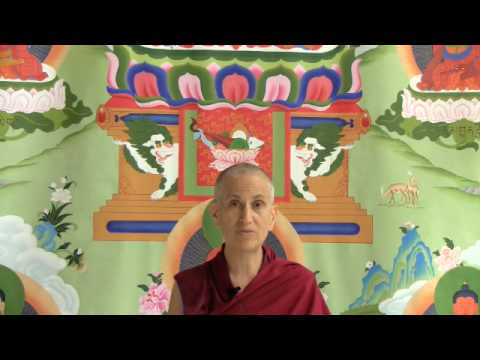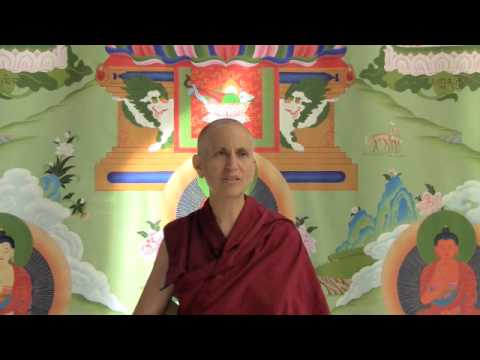Refuge meditation topics
Stages of the Path #61: Refuge Ngöndro Part 10
Part of a series of short talks on the preliminary practice (ngöndro) of taking refuge.
- What to meditate on while doing the refuge chant
- The difference between a religious institution and the Three Jewels as objects of refuge
- The qualities of the Three Jewels
Stages of the Path 61: Refuge meditation topics (download)
I thought I would cover some of the things that you can meditate on while you are doing the refuge “Namo Gurubhya, Namo Buddhaya, Namo Dharmaya, Nama Sanghaya.” One is to think about what does refuge mean and what’s the relationship between taking refuge and trusting in the Three Jewels? Why do we trust the Three Jewels more than ordinary sentient beings? Think about what’s the difference between a religious institution and the Three Jewels as the objects of refuge, because sometimes we get that quite confused.
The Dharma is the path that we’re following and the cessations. The institution is something created by human beings. When we take refuge in the Three Jewels, are we all automatically taking refuge in Buddhist institutions? What’s the relationship to the institutions? That can be something nice to think about, too.
Then also, why are you taking refuge? What is it that motivates you to take refuge? And we have, of course, the causes for refuge listed in the lamrim. Seeing the danger in saṃsāra and particularly lower rebirths and faith in the Three Jewels and compassion for all beings, but is that what really motivates us? Think about what is our motivation—and also to enhance that motivation by trying to cultivate those three causes that are listed in the lamrim.
Think deeply about the qualities of the Three Jewels: the Buddha, Dharma, and Sangha. Do this so we know why we’re taking refuge in them, why they’re worthy objects of refuge. Knowing the difference between the causal and the resultant refuge, because the more we know about what we’re taking refuge in, then the more we’ll understand how to cultivate a good relationship with the Three Jewels and what to expect. Especially if we grew up believing in a theistic religion—we may have one set of expectations that we just project or import into Buddhism that doesn’t apply. But when we really think about what the Three Jewels are, that helps us know what to expect and what kind of relationship we establish with them.
Think, “What did we take refuge in before?”—not only our religion of origin, but just in our regular daily life. How do we take refuge in food, in friends, in distraction, in drugs, in alcohol, in possessions, in status, and so many other things? To really see that taking refuge is something that we’ve been doing our whole life. We have been trying to find a way that protects us from suffering and to have happiness, but we haven’t really understood what refuge is about and what worthy objects of refuge are.
What are the advantages of taking refuge in the Three Jewels? How does that help us grow? It’s interesting also to think, how would my life turn out if I hadn’t taken refuge in the Three Jewels? If I hadn’t met the Dharma, what would I be doing now? What kind of life would I be living? What kind of karma would I be creating? What kind of rebirth could I expect?
Regarding taking refuge with the guru: What’s the purpose of having spiritual mentors and how do you choose them? In other words, what are the qualities you look for and what are the qualities that the scriptures tell us to look for? Sometimes, the criteria we use aren’t the right ones. What does it mean to have a good relationship with our spiritual teachers? How can we create one? How can we enhance one? What are helpful ways for handling difficulties that we may have in our relationships with our spiritual teachers?
How, so far, has refuge helped us? What benefit have we derived from taking refuge and having spiritual mentors until now, and how do we want that to go in the future? Think about how to create good relationships with all of them. How does taking refuge change the way you feel about your spiritual practice and your goals in life, your priorities?
What effect does taking refuge over and over again have on you? In other words, think about your refuge when you first became a Buddhist and what it’s like now. How has it matured and what have been the causes for it maturing? And what have been the results and the effects of it maturing?
Is there anything you feel uncomfortable about with taking refuge? If there is, then try and really isolate what your doubts are. Then ask questions and think about your doubts—and try to resolve them. It doesn’t do any good just to put our doubts down and say, “Oh, I’m not supposed to think that way.” We should ask questions. But when we ask questions, we should think about the answers. We shouldn’t have the attitude of, “You prove it to me and until you prove it to me, I’m not going to believe,” because it’s not anybody else’s job to prove anything to us. People give us information and then we have to think about it ourselves and see if it makes sense. If an explanation doesn’t make sense the first time, don’t just throw it out the window, but think, “Maybe I didn’t get all the information I need. Or maybe I didn’t understand the sequence and the way to think properly here.” Go back and rethink it.
You can see when you take refuge there’s a lot to think about. When you think about these different things, your refuge really deepens. It also makes the practice of taking refuge more interesting because then you’re not just sitting there, reciting the mantra with your mind wandering. But you’re guiding your mind and gaining some understanding as you go.
Venerable Thubten Chodron
Venerable Chodron emphasizes the practical application of Buddha’s teachings in our daily lives and is especially skilled at explaining them in ways easily understood and practiced by Westerners. She is well known for her warm, humorous, and lucid teachings. She was ordained as a Buddhist nun in 1977 by Kyabje Ling Rinpoche in Dharamsala, India, and in 1986 she received bhikshuni (full) ordination in Taiwan. Read her full bio.


